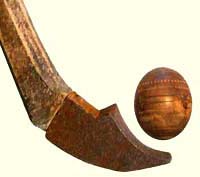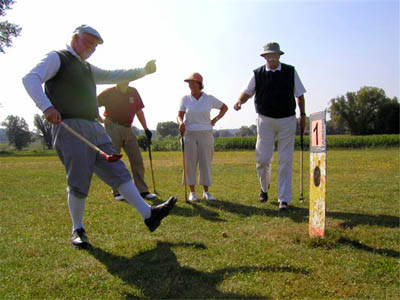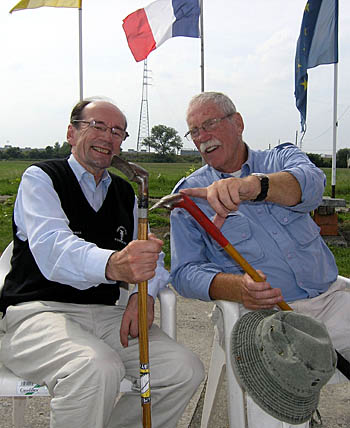

Crosse or
crossage, in English literature often called ‘choule’ or ‘chole’, has its
origin in the ancient counties of Hainaut (Henegouwen) and (French) Flanders,
once both parts of the Low Countries. The first mention of the game dates from
1332.
People played
the crosse game in the streets, on the ramparts and in the fields in and around
the towns. They used curved sticks and elliptical wooden balls.

The essence of the crosse game is to reach a target in a number of strokes decided upon beforehand.
On a crosse field, there are several targets, but there is no fixed routing. Two teams of two players challenge each other. The crosseurs decide what the target will be. One team, the 'chouleurs', tries to reach this target in the agreed number of strokes. If they have all played in turn, the other team, the 'déchouleurs', will try to prevent the first team from achieving their goal by hitting the ball away from the target or into difficult playing positions; they can strike the ball once, and they play in turn. If the first team achieves its objective, it is the winner of the so-called partie. If not, the other team wins. The team that has won the most parties at the end of the match is declared the winner.
The crosseurs play their game in winter on unprepared meadows.
At Carnival, the game of crosse is played with big wooden balls and clubs in the streets of the towns. Beer barrels in front of the cafés are the targets.
Publications on jeu de crosse/choule
Publication |
Author |
Published (in) |
Nature, measure of all things  |
Sara Kieboom-Nijs |
2025 October - Revised chapter from 'Games for Kings & Commoners Part Three', Geert & Sara Nijs (2015) |
Comment va le jeu de crosse aujourd'hui ?  |
Sara Kieboom-Nijs |
2024 November |
Le feu de Saint Antoine, le mal qui accabla la France au 10e siècle |
Ángel Sánchez Crespo |
2024 October National Geographic |
Some reflections about the Catholic Church and the game of crosse |
Sara Kieboom-Nijs |
2024 June - Based on the chapter 'Religion' in 'CHOULE The Non-Royal but most Ancient Game of Crosse', Geert & Sara Nijs (2008) |
The statue of St Anthony, patron saint of all crosseurs, nearly completely restored  |
Sara Kieboom-Nijs |
2023 January |
| Le 17 janvier : fête de Saint Antoine 17 January St Anthony's name day   |
Sara Kieboom-Nijs |
2022 January |
Jeu de crosse in medieval literature  |
Sara Kieboom-Nijs |
2021 November |
Miners and jeu de crosse  |
Sara Kieboom-Nijs |
2021 August |
The crosse  |
Freddy Gallez & Geert Nijs |
2021 - Revised, extended & re-designed English edition of 'CHOULE The Non-Royal but most Ancient Game of Crosse', Geert & Sara Nijs (2008) |
The choulette  |
Freddy Gallez & Geert Nijs |
2021 - Revised, extended & re-designed English edition of 'CHOULE The Non-Royal but most Ancient Game of Crosse', Geert & Sara Nijs (2008) |
Clubs de crosse  |
Freddy Gallez & Geert Nijs |
2017 November |
Choulettes (soules) dans le crossage  |
Freddy Gallez & Geert Nijs |
2017 November |
| Hornu, Hainaut, Belgique & jeu de crosse en 1934  
|
Anonyme/Anonymous |
2017 - Golfika no. 20 (magazine of the European Association of Golf Historians and Collectors) |
Rules for the game of crosse |
Geert & Sara Nijs |
2014 - 'Games for Kings & Commoners - Part Two' |
En quoi consiste le jeu de crosse ?  |
Geert Nijs & Sara Nijs |
2012 - 'Jeu de Crosse Crossage A travers les âges' |
Jeu de Crosse in Belgium  |
John Pearson |
2009 September - Through the Green (magazine of the British Golf Collectors Society) |
'World First' in jeu de crosse  |
Geert & Sara Nijs |
2009 August |
| Bel’œil, Hainaut, Belgique & jeu de crosse en 1901   |
Avec l’aimable atorisation de/By courtesy of André Auquier |
2008 'CHOULE – 'The Non-Royal but most Ancient Game of Crosse' Geert & Sara Nijs |
| The lost book 'Around golf', A.M. Vagliano, 1938  |
André M. Vagliano |
2008 December - Golfika no. 3 (magazine of the European Association of Golf Historians and Collectors) |
St Anthony the Great and Jeu de Crosse |
Geert & Sara Nijs |
2008 March - Through the Green (magazine of the British Golf Collectors Society) |
St Anthony the Great and Jeu de Crosse |
Geert & Sara Nijs |
2007 October - Golfika no. 2 (magazine of the European Association of Golf Historians and Collectors) |
JEU DE CROSSE - The non-royal but most ancient game of 'crosse' |
Geert & Sara Nijs |
2006 - Golfika no. 1 (magazine of the European Association of Golf Historians and Collectors) |
| Germinal (parts in which Emile Zola describes the game of crosse)  |
Emile Zola |
1885 |
| Germinal (parties dans lesquelles Emile Zola décrit le jeu de crosse) |
Emile Zola |
1885 |


‘World
First’ in jeu de crosse
For the first time in the almost thousand years' history of 'choule' (for the Anglo-Saxons) or 'jeu de crosse' or 'crossage' (for the Francophones), golf players from Australia, Belgium, France, Germany, the Netherlands, and Scotland came to the Belgian crosse fields. Here, they got to know this remarkable, very ancient continental golf game in practice.
The historical golf societies of Australia, Britain and Europe were well represented by their respective captains: Michael Sheret, David Hamilton and Christoph Meister.

Michael Sheret, captain of the Australian Golf Heritage Society,
overjoyed at hitting the planchette.
Under the guidance of Marius Hallez, president of the Baudour crosse society, the very proud and friendly crosseurs showed with infinite patience:
- how to play the game
- how to handle the crosse clubs (reversed baseball grip)
- how and when to choose one of the many different ellipsoid balls, from small, heavy and extremely rigid nylon balls to large, light cork balls
- when and how to 'chouler' and 'déchouler', etc.
The players make the crosse clubs and choulettes themselves. There are no pro-shops or Nevada Bob's where you can buy choule equipment.

One of the crosseurs teaches Christoph Meister, captain of the European Association of Golf Historians and Collectors, and Geert Nijs how to proceed from this planchette to the next one.
There is no coordinating 'Saint Andrews’-like organisation to set generally accepted rules. Contrary to the French crosseurs who have fixed rules, the Belgians are free to produce equipment as they like. Hence, you see golf drivers with reinforced (5 mm) strike faces, original crosse clubs with metal shafts, and grips made of insulation tapes. Balls are hand-made from nylon, pressed wood, cork, willow and boxwood.
There are just a few basic rules for the game. Players decide among themselves on how to go about special situations in the field.
The difference between the 'progressive' Belgian game and the 'traditional' French game has become so big that it is hardly possible to hold cross-border tournaments.
The foreign players were stunned by the ingenuity of the sport and the surprising likeness between the royal game of golf and the crosse game.

David Hamilton and Geert Nijs are discussing the ingenious design of the double-purpose club head of the crosse.
Between the teaching and the playing, there were breaks for Belgian beers, traditional crosseur meals, medieval music played on ancient 'cornemuses' (bagpipes) and an accordion, and by singing the old St Anthony's song, since more than 600 years the patron saint of all crosseurs (and of all golfers).
Sara Kieboom-Nijs, the co-author of 'CHOULE The Non-Royal but most Ancient Game of Crosse' and organiser of this unforgettable event, offered in the name of all golfers a statue of St Anthony to the Pic et Plat society, with the plea that the patron saint may help to preserve this fantastic game for many years to come.
